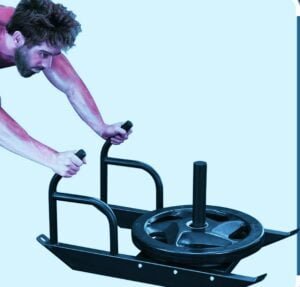The dummy drag is a crucial exercise commonly integrated into emergency response training and fitness regimens.
This exercise simulates the physical demands faced by firefighters, paramedics, and military personnel who might need to drag an incapacitated person to safety.
Beyond its practical applications, the dummy drag is also an excellent way to build overall strength, endurance, and technique.
By engaging multiple muscle groups, including the legs, core, and upper body.
It provides a comprehensive workout that enhances functional fitness.
Mastering the dummy drag can be particularly beneficial for individuals aiming to improve their physical readiness for emergency situations.
The exercise helps train the body to handle real-world scenarios efficiently, fostering both physical and mental resilience.
However, the challenge arises when one does not have access to a training dummy.
Dummies are specialized pieces of equipment that can be expensive and cumbersome, making them less accessible for many individuals or smaller training facilities.
To address this, alternative methods of practicing the dummy drag without a dummy are essential.
These methods can include using household items, weighted objects, or even collaborating with a partner to simulate the drag.
These alternatives not only provide similar physical benefits but also ensure that the essential techniques and muscle engagements are practiced consistently.
Understanding and implementing these methods can make training more accessible and equally effective, regardless of the availability of specialized equipment.
In this section, we will explore the fundamentals of the dummy drag exercise and its significance in training and real-life applications.
We will also delve into the challenges of practicing this exercise without a dummy and the importance of finding effective substitutes.
This foundation will set the stage for comprehending the alternative methods and techniques that can be employed to practice the dummy drag effectively.
Understanding the Mechanics of a Dummy Drag
The dummy drag is a fundamental exercise in many physical training programs, particularly those designed for emergency responders, military personnel, and athletes.
Understanding the mechanics of a dummy drag is crucial for replicating the exercise without an actual dummy.
This exercise primarily involves body positioning, engagement of key muscle groups, and maintaining proper form throughout the movement.
First, let’s break down the body positioning.
The individual performing the dummy drag must squat down to achieve a low center of gravity.
This position ensures stability and reduces the risk of injury.
The feet should be shoulder-width apart, and the back should remain straight to prevent strain.
The performer then grips the object, or imaginary dummy, firmly with both hands, ideally around the chest or shoulders of the “dummy.”
Next, consider the muscle groups engaged during the dummy drag.
The primary muscles involved are the quadriceps, hamstrings, and glutes,
Which are activated during the initial squat and the subsequent lifting motion.
The core muscles, including the abdominals and lower back, play a critical role in maintaining stability and proper posture.
Additionally, the upper body muscles, such as the biceps, triceps, and shoulders, are used to hold and pull the object.
Proper form is essential to maximize efficiency and minimize the risk of injury.
When lifting the dummy, the performer should use their legs rather than their back.
This means engaging the leg muscles to push upwards from the squatting position while keeping the back straight.
During the drag, small steps backward should be taken to maintain control and balance, ensuring that the “dummy” is as close to the performer’s body as possible.
This proximity reduces strain and allows for more efficient movement.
By understanding these mechanics, one can replicate the dummy drag using alternative methods such as dragging a weighted sled, a heavy bag, or even using resistance bands.
These substitutes can provide similar resistance and engage the same muscle groups, allowing for effective practice without the need for an actual dummy.
One effective way to practice dummy drags without an actual dummy is by using sandbags as a substitute.
Sandbags can mimic the weight and resistance of a dummy, providing a realistic training experience.
To begin, it is essential to select the right weight for your sandbag.
Ideally, the sandbag should match the weight of the dummy you would typically use.
This ensures that the training will be as close to the actual scenario as possible.
For most individuals, a sandbag weighing between 100 to 200 pounds is appropriate, depending on your training goals and physical capabilities.
Once you have selected the appropriate weight, securing the sandbags is crucial to ensure they do not shift or spill during the exercise.
Double-bagging the sand with heavy-duty contractor bags and then placing them inside a durable canvas or nylon outer bag can effectively contain and secure the sand.
Additionally, using duct tape or zip ties to reinforce the closure can further prevent leaks.
To perform the drag, start by positioning the sandbag on the ground and practicing proper lifting techniques to avoid injury.
Bend at your knees and use your leg muscles to lift the sandbag.
Once lifted, simulate the dummy drag by grasping the sandbag firmly and pulling it backward in a controlled manner.
It is important to maintain good posture throughout the exercise, keeping your back straight and engaging your core muscles to prevent strain.
Ensuring safety during this practice is paramount.
Always warm up before starting the exercise to prepare your muscles and joints for the physical activity.
Wearing appropriate footwear with good traction can help prevent slips and falls.
Additionally, practicing on a flat, non-slip surface can further reduce the risk of injury.
By following these guidelines, sandbags can be an excellent substitute for a dummy, allowing you to practice and enhance your skills effectively and safely.
When simulating the resistance and weight distribution of dragging a dummy, weighted vests and backpacks can be invaluable tools.
These pieces of equipment allow for a versatile and practical approach to mimic the physical demands of a dummy drag without needing an actual dummy.
The key lies in selecting the appropriate weight, securing the equipment adequately, and maintaining proper form throughout the exercise.
Selecting the Appropriate Weight
Choosing the correct weight is crucial to effectively simulate a dummy drag.
For beginners, it is advisable to start with a lighter load, such as 10-20% of your body weight, and gradually increase as your strength and endurance improve.
Advanced practitioners might aim for weights closer to 30-40% of their body weight.
The goal is to find a balance that challenges your muscles without causing strain or risking injury.
Securing the Equipment
Properly securing the weighted vest or backpack is essential for both safety and effectiveness.
Ensure that the vest or backpack fits snugly to your body, avoiding any loose straps or components that could shift during the exercise.
For weighted vests, adjust the straps to distribute the weight evenly across your torso.
When using a backpack, fill it with evenly distributed weights, such as sandbags or weight plates, and ensure it is tightly secured to prevent movement that could disrupt your form.
Maintaining Proper Form
Maintaining proper form is critical to prevent injury and maximize the benefits of the exercise.
When practicing the drag, keep your back straight and engage your core muscles to support your spine.
Bend at the knees and hips, not the waist, to maintain a stable center of gravity.
As you drag the weighted vest or backpack, focus on using your leg muscles rather than relying solely on your upper body strength.
This will help mimic the full-body effort required in an actual dummy drag.
By incorporating weighted vests and backpacks into your training regimen, you can effectively simulate the physical demands of a dummy drag.
With careful attention to weight selection, equipment security, and proper form.
These tools can provide a practical and efficient means to enhance your strength and endurance.
Partner Drags as an Effective Alternative
Practicing dummy drags without an actual dummy can be effectively achieved through partner drags.
This method offers a dynamic, real-time feedback mechanism, closely simulating the experience of dragging a weighted dummy.
Partner drags not only enhance realism but also allow for immediate corrections and adjustments, fostering a more interactive training environment.
To ensure the safety and efficacy of partner drags, clear communication between partners is paramount.
Before initiating the exercise, participants should establish a set of signals or commands to indicate readiness, fatigue, or the need to stop.
This communication protocol minimizes the risk of injury and ensures both individuals are on the same page throughout the practice session.
Physical safety considerations are equally crucial.
It’s important to use proper lifting techniques to avoid strain or injury.
The individual being dragged should maintain a relaxed posture, keeping their body as limp as possible to simulate a real dummy.
The dragger should focus on using their legs and core to lift and pull, rather than relying solely on upper body strength.
This not only mimics real-life scenarios but also prevents potential back injuries.
Another aspect to consider is the usage of appropriate attire and protective gear.
Wearing gloves can improve grip and reduce the risk of abrasions, while knee pads can offer additional protection during the exercise.
Additionally, practicing on a soft surface, such as grass or padded flooring, can further reduce the likelihood of injuries.
Incorporating partner drags into training routines provides a practical alternative to using a dummy.
It enhances the authenticity of the practice and enables participants to develop better communication and physical coordination, which are essential skills in real-life emergency scenarios.
By adhering to safety protocols and maintaining open lines of communication, partner drags can become a valuable component of any training regimen.

Using Resistance Bands for Training
Resistance bands offer a versatile and effective means to replicate the resistance experienced during a dummy drag.
These bands can simulate the varying levels of difficulty encountered in real-life scenarios, making them an invaluable tool for training.
To start, you’ll need to securely anchor the resistance bands to a fixed object.
This could be a sturdy pole, a heavy-duty door anchor, or any immovable structure capable of withstanding substantial force.
Once anchored, position yourself in a stance that mimics the posture you would assume while dragging a dummy.
Typically, this means standing with your feet shoulder-width apart, knees slightly bent, and your body leaning slightly forward.
Grasp the handles or ends of the resistance bands firmly. Begin by practicing basic pulling motions.
Ensure that your movements are slow and controlled, emphasizing form over speed.
This approach not only prevents injury but also ensures that you are engaging the correct muscle groups effectively.
To intensify the training, you can incorporate various movements. Start with a standard drag by walking backward while maintaining a firm grip on the bands.
Then, progress to lateral movements, which involve stepping sideways while pulling the bands.
This variation mimics the lateral shifts often required during a real dummy drag.
Additionally, practicing forward lunges while pulling the bands can enhance your core stability and overall strength.
The primary advantage of using resistance bands is their ability to provide variable resistance.
Unlike free weights, which offer constant resistance, bands become progressively more challenging the further they are stretched.
This characteristic closely mirrors the increasing difficulty of dragging a heavier dummy over a longer distance.

Furthermore, resistance bands facilitate controlled movements, reducing the risk of abrupt, jerky motions that could lead to injury.
Incorporating resistance bands into your training regimen can significantly enhance your strength, endurance, and technique, ensuring you are well-prepared for the physical demands of a real dummy drag.
By practicing consistently and focusing on controlled movements, you can effectively mimic the resistance and challenges faced during actual scenarios.
Building Core and Grip Strength
When preparing for a dummy drag, the importance of building core and grip strength cannot be overstated.
These muscle groups are crucial for maintaining stability and control during the drag, ensuring efficient and safe execution.
Core strength, which encompasses the muscles of the lower back, abdomen, and pelvis, provides the necessary support for your spine and overall body posture.
Meanwhile, grip strength is essential for securely holding onto the dummy or any other object used in practice.
Several exercises can effectively target these muscle groups. Planks, for instance, are excellent for strengthening the core.
To perform a plank, position yourself face down with your forearms and toes on the ground.
Keep your body in a straight line from head to heels and hold the position for as long as possible.
This exercise not only engages your core but also enhances overall body endurance.
Deadlifts are another fundamental exercise that benefits both core and grip strength.
By lifting a weighted barbell from the ground to a standing position, deadlifts engage the lower back, glutes, hamstrings, and grip muscles.

Proper form is essential to avoid injury, so focus on maintaining a straight back and using your legs to lift the weight.
Farmer’s carries are particularly effective for building grip strength.
In this exercise, you hold a heavy weight in each hand and walk a specified distance.
This mimics the action of holding onto a dummy during a drag, making it a practical addition to your training regimen.
Start with a manageable weight and gradually increase as your strength improves.
Grip trainers, such as hand grippers, can also be incorporated into your routine.
These tools specifically target the muscles in your hands and forearms, enhancing your ability to maintain a strong grip over extended periods.

Here is a sample workout routine to build core and grip strength:
- Planks: 3 sets of 1-minute holds
- Deadlifts: 3 sets of 8-12 reps
- Farmer’s carries: 3 sets of 30-meter walks
- Grip trainers: 3 sets of 15 reps per hand
Integrating Dummy Drag Practice into Your Training Routine
Incorporating alternative dummy drag methods into your regular training schedule requires a strategic approach to ensure effective skill development and physical conditioning.
To start, consider the frequency of your training sessions.
It is advisable to integrate dummy drag practice two to three times a week, allowing adequate recovery time between sessions to prevent overtraining and injury.
Progression is a key component in this training.
Begin with lighter weights and shorter distances to build foundational strength and technique.
As your proficiency improves, gradually increase the weight and distance to continue challenging your muscles and cardiovascular system.
For instance, start with dragging a weighted sled over 10 yards and progressively extend the distance while adding weight incrementally.
Combining different techniques can offer a comprehensive training regime.
Alternate between various methods such as using resistance bands, weighted vests, and partner drags to target different muscle groups and mimic real-life scenarios more effectively.
This variation not only keeps the training engaging but also promotes balanced muscle development and improves overall functional strength.
Tracking your progress is essential for maintaining motivation and adjusting your routine as necessary.
Keep a detailed log of the weights used, distances covered, and any observed improvements in technique and strength.
Regularly review this log to identify patterns and make informed adjustments to your training regimen.
For instance, if you notice a plateau in your progress, consider incorporating supplementary exercises like squats and deadlifts to enhance your overall strength.
As your strength and technique improve, continue to adjust your routine to maintain a progressive overload.

This might include diversifying the terrain on which you practice.
Incorporating interval training to boost endurance.
Or integrating more complex scenarios that require rapid adaptability.
By systematically integrating these alternative dummy drag methods into your training.
You can develop the necessary skills and strength to perform dummy drags effectively.
Even without access to a traditional dummy.
Share your thoughts on dummy drag exercise.



